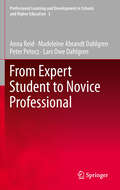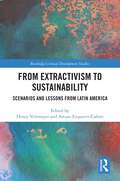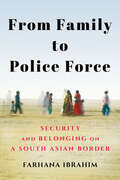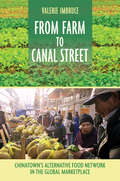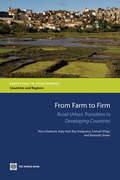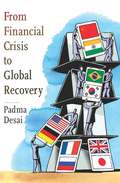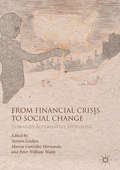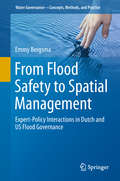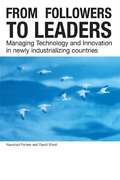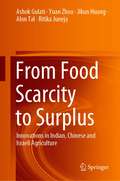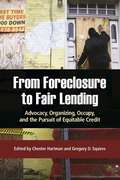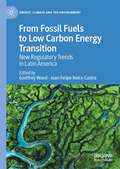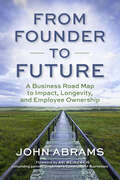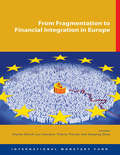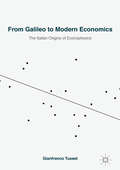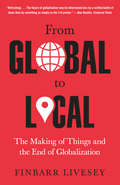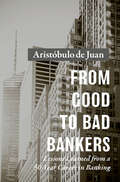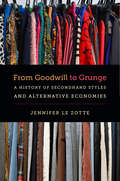- Table View
- List View
From Expert Student to Novice Professional
by Anna Reid Peter Petocz Madeleine Abrandt Dahlgren Lars Owe DahlgrenStudents entering higher education expect their studies to lead them towards some specific form of professional career. But in this age, complex internationalized professions are the main source of work for graduates, so students need to prepare themselves for a future that can be volatile, changeable and challenging. This book shows how students navigate their way through learning and become effective students; it details how to shift the focus of their learning away from the formalism associated with the university situation towards the exigencies of working life. It is in this sense that the book explores how people move from being expert students to novice professionals. This book presents a model of professional learning fashioned out of a decade of research undertaken in countries half a world away from each other--Sweden and Australia. It uses empirical research gathered from students and teachers to show how students negotiate the forms of professional knowledge they encounter as part of their studies and how they integrate their understandings of a future professional world with professional knowledge and learning. It reveals that as students move from seeing themselves as learners, they take on more of a novice professional identity which in turn provides a stronger motivation for their formal studies.
From Extractivism to Sustainability: Scenarios and Lessons from Latin America (Routledge Critical Development Studies)
by Henry Veltmeyer Arturo Ezquerro-CañeteThis book investigates how extractive capitalism has developed over the past three decades, what dynamics of resistance have been deployed to combat it, and whether extractivism can ever be transformed into being a part of a progressive development path. It was not until the 20th century that the extraction of natural resources and raw materials took on a decidedly capitalist form, with the global north extracting primary commodities from the global south as a means of capital accumulation. This book investigates whether extractivism, despite its well-documented negative and destructive socioenvironmental impacts and the powerful forces of resistance that it has generated, could ever be transformed into a sustainable post-development strategy. Drawing on diverse sectoral forms of extractivism (mining, fossil fuels, agriculture), this book analyses the dynamics of both the forces of resistance generated by the advance of extractive capital and alternate scenarios for a more sustainable and liveable future. The book draws particularly on the Latin American experience, where both the propensity of capitalism towards crisis and the development of resistance dynamics to ‘extractive’ capital have had their greatest impact in the neoliberal era. This book will be of interest to researchers and students across development studies, economics, political economy, environmental studies, Indigenous studies, and Latin American affairs.
From Family to Police Force: Security and Belonging on a South Asian Border (Police/Worlds: Studies in Security, Crime, and Governance)
by Farhana IbrahimFrom Family to Police Force illuminates the production and contestation of social, familial, and national order on a South Asian borderland. In the borderland that divides Kutch, a district in the western Indian state of Gujarat, from Sindh, a southern province in Pakistan, there are many forces at work: civil and border police, the air wing of the armed forces, paramilitary forces, and various intelligence agencies that depute officers to the region. These groups are the major actors in the field of security and policing. Farhana Ibrahim offers a bird's-eye view of these groups, drawing on long-standing anthropological engagement with the region. She observes policing on multiple levels, showing in detail that the nation-state is only one of the scales at which policing is enacted at a borderland. Ibrahim draws on multiple sources and forms of policing structure to illuminate everyday interaction on the personal scale, bringing families and individuals into the broader picture. From Family to Police Force looks beyond the obvious sites, sources, and modes of policing to show the distinctions between the act of policing and the institution of the police.
From Farm Boy to Financier: Eiichi Shibusawa and the Creation of Modern Japan
by Geoffrey G. Jones Gabriel Ellsworth Ryo TakahashiThis case describes the career of Eiichi Shibusawa (1840-1931), a serial entrepreneur who is widely known as the "father of Japanese capitalism" and as a pioneer of socially responsible investment. Born in feudal Edo Japan, following the Meiji Restoration in 1868 Shibusawa transitioned to working for the government in the new Ministry of Finance. He played a central role in the creation of Dai'Ichi Bank, a national bank and Japan's first joint stock company, in 1873. He subsequently became a prolific venture capitalist, being involved in founding nearly 500 companies and 600 public organizations over the course of his lifetime. The companies he founded, such as Oji Paper, Tokio Marine Insurance Company, and the Osaka Spinning Company were central to the modernization of the Japanese economy. He was also active in forming business associations, including the Tokyo Bankers Association, and supported many social enterprises in education. In 1901 he was associated with the founding of the Japanese Women's University, the first private university for women. Shibusawa was a student of Confucianism and developed the concept of gappon shugi, which has been variously translated as ethical or stakeholder capitalism. While traditional Confucianism in Japan had regarded commerce as lacking virtue, Shibusawa argued that creating wealth was a virtuous activity. He believed that ethical principles had to be central to the pursuit of wealth, and that business must serve all stakeholders, so that the country as a whole could flourish.
From Farm to Canal Street: Chinatown's Alternative Food Network in the Global Marketplace
by Valerie ImbruceOn the sidewalks of Manhattan's Chinatown, you can find street vendors and greengrocers selling bright red litchis in the summer and mustard greens and bok choy no matter the season. The neighborhood supplies more than two hundred distinct varieties of fruits and vegetables that find their way onto the tables of immigrants and other New Yorkers from many walks of life. Chinatown may seem to be a unique ethnic enclave, but it is by no means isolated. It has been shaped by free trade and by American immigration policies that characterize global economic integration. In From Farm to Canal Street, Valerie Imbruce tells the story of how Chinatown's food network operates amid--and against the grain of--the global trend to consolidate food production and distribution. Manhattan's Chinatown demonstrates how a local market can influence agricultural practices, food distribution, and consumer decisions on a very broad scale. Imbruce recounts the development of Chinatown's food network to include farmers from multimillion-dollar farms near the Everglades Agricultural Area and tropical "homegardens" south of Miami in Florida and small farms in Honduras. Although hunger and nutrition are key drivers of food politics, so are jobs, culture, neighborhood quality, and the environment. Imbruce focuses on these four dimensions and proposes policy prescriptions for the decentralization of food distribution, the support of ethnic food clusters, the encouragement of crop diversity in agriculture, and the cultivation of equity and diversity among agents in food supply chains. Imbruce features farmers and brokers whose life histories illuminate the desires and practices of people working in a niche of the global marketplace.
From Farm to Firm
by Nora Dudwick Katy Hull Roy Katayama Forhad Shilpi Kenneth SimlerThe process of rural-urban transformation presents both opportunities and challenges for development. If managed effectively, it can result in growth that benefits everyone; if managed poorly, it can lead to stark welfare disparities and entire regions cut off from the advantages of agglomeration economies. The importance of rural-urban transition has been confirmed by two consecutive World Development Reports: WDR 2008 Agriculture for Development; and WDR 2009 Reshaping Economic Geography. Focusing on Sub-Saharan Africa and South Asia, this book picks up where the WDRs left off, investigating the influence of country conditions and policies on the pace, pattern, and consequences of rural-urban transition and suggesting strategies to ensure that its benefits results in shared improvements in well-being. The book uncovers vast inequalities, whether between two regions of one country, between rural and urban areas, or within cities themselves. The authors find little evidence to suggest that these inequalities will automatically diminish as countries develop: empirical and qualitative analysis suggests that spatial divides are mainly a function of country conditions, policies and institutions. By implication, policymakers must take active steps to ensure that rural-urban transition results in shared growth. Spatially unbiased provision of health and education services is crucial to ensuring that the benefits of transition are shared by all. But connective infrastructure and targeted interventions also emerge as important considerations, even in countries with severely constrained fiscal and administrative capacity. The authors suggest steps for navigating the tricky political economy of land reforms. And they alert readers to potential spillover effects that mean that policies designed for one space can have unintended consequences on another. Policymakers and development experts, as well as anyone concerned with the impact of rural-urban transition on growth and equity, will find this book a thought-provoking and informative read.
From Financial Crisis to Global Recovery
by Padma DesaiIn this wise and thoughtful analysis of the global financial crisis, Padma Desai, who teaches at the Columbia University, makes the complexities of economic policy and reform accessible to a wide audience. Merging a compelling narrative with scholarly research, she begins with a systematic breakdown of the factors leading to America s recent recession, describing the monetary policy, tax practices, sub-prime mortgage scandals and lax regulation that contributed to the crisis, and frankly assesses whether the US economy is truly on the mend. Expanding her view, she considers the prospects for recovery in North America as a whole, as well as in Europe, Asia, and South America, and the extent and value of US and EU regulatory proposals. She concludes with a historical comparison of the Great Depression and the Great Recession, weighing the effect of the economic collapse on the future of American capitalism.
From Financial Crisis to Global Recovery
by Padma DesaiIn this book, Padma Desai makes the complexities of economic policy and financial reform accessible to a wide audience. Merging a compelling narrative with scholarly research, she begins with a systematic breakdown of the factors leading to America's recent recession, describing the monetary policy, tax practices, subprime mortgage scandals, and lax regulation that contributed to the crisis. She also discusses the Treasury-Fed rescue deals that saved several financial institutions and the involvement of Congress in passing restorative policies. Desai follows with an analysis of stress tests and other economic measures, and she frankly assesses whether the U.S. economy is truly on the mend. Expanding her view, she considers the prospects for recovery in North America as a whole, as well as in Europe, Asia, and South America, and the extent and value of U.S. and E.U. regulatory proposals. Refocusing on American financial practices, Desai evaluates hedge funds and derivatives, credit default swaps, and rating agencies, pondering whether the dollar can remain a reserve currency. She concludes with a historical comparison of the Great Depression and the Great Recession, weighing the effect of the economic collapse on the future of American capitalism.
From Financial Crisis to Social Change: Towards Alternative Horizons
by Torsten Geelan Marcos González Hernando Peter William WalshThis edited collection critically engages with a range of contemporary issues in the aftermath of the North Atlantic financial crisis that began in 2007. From challenging the erosion of academic authority to the myth that parliamentary democracy is not worth engaging with, it addresses three interrelated questions facing young people today: how to reclaim our universities, how to revitalise our democracy and how to recast politics in the 21st century. This book emphasises the crucial importance of generational experience as a wellspring for progressive social change. For it is the young generations who have come of age in a world marred by crises that are at the forefront of challenging the status quo. With insight into new social movements and protests in the UK, Canada, Greece and Ukraine, this stimulating collection of works will be invaluable for those teaching, studying and campaigning for alternatives. It will also be of relevance to scholars in social movement studies, the sociology and anthropology of economic life, the sociology of education, social and political theory, and political sociology.
From Financial Crisis to Stagnation
by Thomas I. PalleyThe US economy today is confronted with the prospect of extended stagnation. This book explores why. Thomas I. Palley argues that the Great Recession and destruction of shared prosperity is due to flawed economic policy over the past thirty years. One flaw was the growth model adopted after 1980 that relied on debt and asset price inflation to fuel growth instead of wages. A second flaw was the model of globalization that created an economic gash. Financial deregulation and the house price bubble kept the economy going by making ever more credit available. As the economy cannibalized itself by undercutting income distribution and accumulating debt, it needed larger speculative bubbles to grow. That process ended when the housing bubble burst. The book explains why the economy is now confronted with stagnation rather than the quick recovery predicted by other accounts.
From Financialisation to Innovation in UK Big Pharma: AstraZeneca and GlaxoSmithKline (Elements in Reinventing Capitalism)
by William Lazonick Antonio Andreoni Öner TulumThe tension between innovation and financialisation is central to the business corporation. Innovation entails a 'retain-and-reinvest' allocation regime that can form a foundation for stable and equitable economic growth. Driven by shareholder-value ideology, financialisation entails a shift to 'downsize-and-distribute'. This Element investigates this tension in global pharmaceuticals, focusing on the two leading UK companies AstraZeneca and GlaxoSmithKline. In the 2000s both adopted US-style governance, including stock buybacks and stock-based executive pay. Over the past decade, however, first AstraZeneca and then GlaxoSmithKline transitioned to innovation. Critical was the cessation of buybacks to refocus capabilities on investing in an innovative drugs pipeline. Enabling this shift were UK corporate-governance institutions that mitigated US-style shareholder-value maximisation. Reinventing capitalism for the sake of stable and equitable economic growth means eliminating value destruction caused by financialisation and supporting value creation through collective and cumulative innovation. This title is also available as Open Access on Cambridge Core.
From Flood Safety to Spatial Management: Expert-Policy Interactions in Dutch and US Flood Governance (Water Governance - Concepts, Methods, and Practice)
by Emmy BergsmaThis book deals with the introduction of a new type of “spatial measures" in flood governance. In contrast to traditional “safety measures" that aim to provide protection against floods by building structural flood defenses such as levees and flood walls, the goal of spatial measures is to reduce the exposure to flood risks by changing the spatial layout of flood-prone areas. By limiting developments and flood-proofing buildings in areas at risk to flooding, investments in structural flood defenses can be circumvented and vulnerabilities reduce. World-wide, spatial measures are gaining attractiveness as a response strategy to increasing flood risks caused by climate change and urbanization. The introduction of spatial measures in flood governance involves more than the simple development of new policies and laws. Research has demonstrated that the implementation of spatial measures can have huge implications for how costs and responsibilities are divided between different levels of governance and between public and private actors, changing the whole organization behind flood governance. Both for the effectiveness and for the legitimacy of spatial flood governance strategies, it is important that these distributive implications are well understood. This book describes the introduction of spatial measures in the context of two very different delta countries: the Netherlands and the United States. In the United States, a spatial flood governance strategy was already developed in de mid-20th century whereas in the Netherlands, a safety paradigm institutionalized over the course of the 20th century and spatial measures have only recently been introduced. By analyzing the science-policy interactions underlying the implementation of spatial measures in both countries, this book shows how under the influence of different types of experts (engineers in the Netherlands and social geographers in the United States) different spatial flood management strategies emerged with different distributive implications, each with its own challenges for effectiveness and legitimacy.
From Followers to Leaders: Managing Technology and Innovation
by Naushad Forbes David WieldThe last years have seen a profusion of books and articles on managing technology, focused almost exclusively on leading edge firms in leading edge countries. This book argues that succeeding as a follower-firm requires learning from many experiences and avoiding simplistic 'how-to' approaches that prescribe one best practice. Individual chapters cover: * the role of innovation on the shop-floor* the importance of mixing process and product innovation* the challenges involved in building an innovation culture* the special role of R&D and design. These topics instruct a deeper understanding of strategy in follower-firms, simultaneously providing insight for public policy in building local technological capacity. Forbes and Wield argue that there are many 'leading edges' which appear in the most unlikely places. Their book contains major case studies from many different firms in twelve countries over five continents, in industry segments as diverse as pharmaceuticals, software, garments, beer and steel. This informative book for students, researchers and professionals in the fields of business, management and information technology shows that successful experiences can arise anywhere in the world.
From Food Scarcity to Surplus: Innovations in Indian, Chinese and Israeli Agriculture
by Alon Tal Ashok Gulati Yuan Zhou Jikun Huang Ritika JunejaThis book brings together unique experiences of India, China and Israel in overcoming economic, social, and natural resource challenges. Through its eleven chapters, the book captures the role of groundbreaking innovations in achieving unprecedented agricultural growth and stabilizing these nations. It provides a future outlook of the new challenges that will confront these countries in 2030 and beyond, related to tackling food and nutrition security, sustainable agricultural growth and adhering to improved food safety standards. This book provides useful insights for exploring technological innovations and policies that can address these future challenges and develop profitable and sustainable agriculture. This volume also highlights valuable lessons that India, China and Israel provide for the rest of the developing world where population is growing fast; natural resources are limited; and it is a challenge to produce enough food, feed and fibre for their populations. Tracing the historical past, this book is an impressive resource for academicians, policymakers, practitioners, agribusiness players, entrepreneurs in understanding the role of innovations in addressing future challenges.
From Foreclosure to Fair Lending: Advocacy, Organizing, Occupy, and the Pursuit of Equitable Credit
by Edited by Chester Hartman and Gregory D. SquiresThis book informs a renewed movement for fair lending and fair housing. Leading advocates and specialists examine strategic initiatives to realize objectives of the federal Fair Housing Act as well as state and local lawsWell-known fair housing and fair lending activists and organizers examine the implications of the new wave of fair housing activism generated by Occupy Wall Street protests and the many successes achieved in fair housing and fair lending over the years. The book reveals the limitations of advocacy efforts and the challenges that remain. Best directions for future action are brought to light by staff of fair housing organizations, fair housing attorneys, community and labor organizers, and scholars who have researched social justice organizing and advocacy movements. The book is written for general interest and academic audiences.Contributors address the foreclosure crisis, access to credit in a changing marketplace, and the immoral hazards of big banks. They examine opportunities in collective bargaining available to homeowners and how low-income and minority households were denied access to historically low home prices and interest rates. Authors question the effectiveness of litigation to uphold the Fair Housing Act's promise of nondiscriminatory home loans and ask how the Consumer Financial Protection Bureau is assuring fair lending. They also look at where immigrants stand, housing as a human right, and methods for building a movement.
From Fossil Fuels to Low Carbon Energy Transition: New Regulatory Trends in Latin America (Energy, Climate and the Environment)
by Geoffrey Wood Juan Felipe Neira-CastroFocusing on five key themes - hydrocarbons, electricity, mining, social license to operate, and arbitration/dispute resolution- via in-depth country and regional case studies, this book seeks to capture the contrasting and sometimes conflicting trends in energy governance in Latin America as it wrestles with a dependence on fossil fuels whilst shifting toward a low carbon future. Energy transition continues to sit at the centre of the Latin American policy debate as the world continues to push for carbon neutrality by 2050. Latin America is undergoing a renewable energy transition, with substantial reserves (solar, wind, hydro, geothermal) and many countries in the region setting ambitious renewable energy policies, laws, and regulations to address climate change. However, recent initiatives to promote renewables must be placed in context. Historically, Latin America has developed and improved its economic and social standards due primarily to an economy based on the extractive industries and fossil fuels. This places renewables at the crossroads of multiple drivers, as the region seek to ensure security of supply, attract investment, and facilitate a low carbon energy transition.
From Founder to Future: A Business Roadmap to Impact, Longevity, and Employee Ownership
by John AbramsLearn how to transition leadership, implement shared ownership, and preserve your organization's core values-setting the stage for your business to thrive for generations to come.This visionary but practical handbook offers mission-driven business owners a roadmap for ensuring their company's lasting impact, building leadership internally, and fostering participatory management.Through inspiring real-world stories of B-Corps, worker co-ops, ESOPs, and employee ownership trusts, this book demonstrates how to create resilient organizations that benefit workers and communities.Drawing on his 50-year journey with South Mountain Company and extensive research, Abrams outlines five critical transitions for mission-driven businesses to become what he calls a CommonWealth company:• From founder to next-generation leadership• From sole ownership to widely shared• From hierarchical control to democratic management• From unprotected mission to preserved purpose• From business-as-usual to B Corp force for goodFrom Founder to Future is an essential guide for mission-driven leaders seeking to reshape their businesses for inclusivity, longevity, and positive impact. Whether you're a retiring owner planning your exit, a young entrepreneur building for the future, or an employee working in a purpose-driven business, this book offers a blueprint for creating enduring, values-driven enterprises in the emerging regenerative economy. As 3,000,000 U.S. small business founders over 55 prepare to retire, $10 trillion in assets will change hands over the next two decades. This timely guide shows how to preserve your company's mission and legacy while empowering the next generation.
From Fragmentation to Financial Integration in Europe
by Thierry Tressel Charles Enoch Jianping Zhou Luc EveraertA report from the International Monetary Fund.
From GOP to NFT: Anthony Scaramucci and the Launch of Flatter NFT
by Lauren H. Cohen Richard Ryffel Grace HeadingerAnthony Scaramucci, Managing Director of SkyBridge Capital, considered whether he should officially greenlight the launch of SkyBridge's own NFT platform - Flatter NFT. He had led the investment firm to push first into Bitcoin and then Ethereum to make SkyBridge a central node in the crypto industry. He further believed SkyBridge could differentiate itself from OpenSea and other platforms by tying non-fungible tokens with fungible experiences. The technology behind the platform was solidly proven. However, in his head he weighed the tradeoff between launching a full platform versus other ways of investing in the space. With a potential announcement of the platform pending for the September 2021 SALT NYC conference, Scaramucci believed now was the time to make a decision. The NFT space swelled in users and value by the day. Should SkyBridge jump in or move on to another venture?
From Galileo to Modern Economics: The Italian Origins of Econophysics
by Gianfranco TussetEmpirical laws are rare in economics. This book describes efforts to anchor economic knowledge to invariant empirical laws. It links 17th and 18th century Galilean monetary economists to econophysics, a field that emerged in the mid-1990s. This virtual journey from past to present is charted by episodes on aggregates and empirical primacy. It includes the virtually unknown story of 19th century scholars who, by searching for a stricter mathematical approach, paved the way to an ‘engineering’ view of economics. Then there are celebrities like Pareto and his first empirical law governing the distribution of wealth. Pareto and Amoroso sparked a debate on the skewed distribution that spanned decades, ranging from finance to market transformations, to econophysics, with its concepts and tools inherited from statistical physics. The last stage of the journey goes through econophysics and the recent gradual advances it has made, which show how its position vis-à-vis economics has been changing.
From Global to Local: The World Of Things And The End Of Globalization
by Finbarr LiveseyThis brilliantly original book dismantles the underlying assumptions that drive the decisions made by companies and governments throughout the world, to show that our shared narrative of the global economy is deeply flawed. If left unexamined, they will lead corporations and countries astray, with dire consequences for us all. For the past fifty years or so, the global economy has been run on three big assumptions: that globalization will continue to spread, that trade is the engine of growth and development, and that economic power is moving from the West to the East. More recently, it has also been taken as a given that our interconnectedness—both physical and digital—will increase without limit. But what if all these ideas are wrong? What if everything is about to change? What if it has already begun to change but we just haven't noticed?Increased automation, the advent of additive manufacturing (3D printing, for example), and changes in shipping and environmental pressures, among other factors, are coming together to create a fast-changing global economic landscape in which the rules are being rewritten—at once a challenge and an opportunity for companies and countries alike.
From Gold Teeth to Gold Jacket: My Life in Football and Business
by John Harris Edgerrin JamesHow a young man with a solid work ethic carried himself out of poverty to the pinnacle of professional sports and business. Before he turned sixteen, Edgerrin James had already developed the critical thinking and mental discipline required for him to become one of the most astute business minds in professional sports. Acclaimed as one of the greatest running backs of his generation who was inducted into the 2020 Pro Football Hall of Fame, James is a self-made financial whiz and philanthropist. Selected by the Indianapolis Colts with the fourth overall pick in the 1999 NFL Draft and signing the largest contract for a rookie running back in league history, James amassed over 12,000 rushing yards, was a four-time NFL All-Pro, and led the league in rushing in each of his first two seasons. In his new memoir, From Gold Teeth to Gold Jacket, with award-winning sports journalist John Harris and a foreword from fellow teammate and Hall of Famer Peyton Manning, James shares his unique, no-holds-barred perspective in becoming an all-time NFL great while also building a financial empire while raising six children. The product of a single-parent household in one of the most downtrodden rural areas in the state of Florida, James balanced life as a young father as he became one of the best players in college football at the University of Miami. Later, facing what seemed like an insurmountable obstacle after reaching the pros, he overcame a devastating knee injury to leave an indelible mark on the sport. When his football career ended prematurely following the tragic death of the mother of his children, James made a seamless transition to become a successful businessman. This tell-all book, featuring colorful anecdotes from his football career and personal life delivered in conversational prose, draws parallels between sports and business and guides readers on how to develop their own personal game plan to reach their maximum potential.
From Good to Bad Bankers: Lessons Learned from a 50-Year Career in Banking
by Aristóbulo de JuanBankers are administrators of other people’s money, and they are responsible both to their depositors and to other stakeholders. Human nature being what it is, however, they sometimes fall prey to overweening ambition, coming to see themselves as the rightful beneficiaries of the moneys entrusted to them. This can lead them to make poor lending decisions and engage in risky practices, eventually moving on to cosmetic accounting and the concealment of problems, speculation and even outright fraud.Supervisors are there to prevent such behaviour, of course. They are responsible to government and the general public alike for the stability of the financial system, the proper allocation of financial resources by the banks and the protection of depositors and creditors. Their responsibility is, then, subsidiary to that of the bankers themselves.Where supervision is lax and ineffective, however, it encourages bad management by bankers, creating a vicious circle that eventually leads to financial crises, which has most often to be cured using tax-payers’ money. Of course, it also hurts the broader economy. That is why the inseparable trio of regulation, supervision and resolution must exist.In this collection of his writings over a period of some 50 years, Aristóbulo de Juan describes the causes, characteristics and consequences of financial crises based on his own experience as a central banker, world bank expert and consultant spanning a career of more than 55 years.In a nutshell, the papers brought together in this book recount circumstances that have always plagued banking, and that are only too likely to recur in the future.
From Goods to a Good Life: Intellectual Property and Global Justice
by Madhavi SunderMost scholarship on intellectual property considers this law from the standpoint of law and economics. Under this conventional wisdom, intellectual property is simply a tool for promoting innovative products, from iPods to R2D2. In this highly original book Madhavi Sunder calls for a richer understanding of intellectual property law's effects on social and cultural life. Intellectual property does more than incentivize the production of more goods. This law fundamentally affects the ability of citizens to live a good life. Intellectual property law governs the abilities of human beings to make and share culture, and to profit from this enterprise in a global Knowledge economy. This book turns to social and cultural theory to more fully explore the deep connections between cultural production and human freedom.
From Goodwill to Grunge: A History of Secondhand Styles and Alternative Economies (Studies in United States Culture)
by Jennifer Le ZotteIn this surprising new look at how clothing, style, and commerce came together to change American culture, Jennifer Le Zotte examines how secondhand goods sold at thrift stores, flea markets, and garage sales came to be both profitable and culturally influential. Initially, selling used goods in the United States was seen as a questionable enterprise focused largely on the poor. But as the twentieth century progressed, multimillion-dollar businesses like Goodwill Industries developed, catering not only to the needy but increasingly to well-off customers looking to make a statement. Le Zotte traces the origins and meanings of "secondhand style" and explores how buying pre-owned goods went from a signifier of poverty to a declaration of rebellion.Considering buyers and sellers from across the political and economic spectrum, Le Zotte shows how conservative and progressive social activists--from religious and business leaders to anti-Vietnam protesters and drag queens--shrewdly used the exchange of secondhand goods for economic and political ends. At the same time, artists and performers, from Marcel Duchamp and Fanny Brice to Janis Joplin and Kurt Cobain, all helped make secondhand style a visual marker for youth in revolt.
